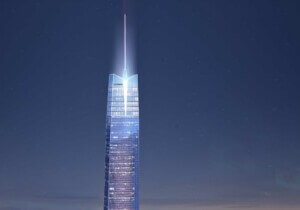One hundred and thirty-three years after the first skyscraper appeared, in an era when air rights are just another tradable commodity and globalization can make one city feel much like another, Scott Johnson argues compellingly in Essays on the Tall Building and the City that skyscrapers have become a reflection of their particular region. To prove his point, the architect and cofounder of Los Angeles–based firm Johnson Fain closely analyzes high-rises in New York City, London, Paris, Tokyo, Shanghai, Abu Dhabi, and São Paulo through a series of essays and lush photographic spreads. In each essay, Johnson provides richly detailed context about the particular city’s history and its approach toward urban planning. His selection of cities is not accidental; from one of the newest metropolises to some of the oldest, Johnson demonstrates how each region’s tall buildings are shaped by a particular history and culture.
In his chapter on Paris, Johnson delves into the city’s ruthless zoning practices, from the 1850s push to transform medieval alleyways and pedestrian haunts into grand, easily patrolled boulevards, to the 20th-century creation of perimeter “new towns” that encouraged growth only on the outskirts of the central city. Famously, the city banned all high-rises in 1972 after the public outcry over the Tour Maine-Montparnasse. As a result, many of Paris’s built skyscrapers bear a kind of hushed, almost reticent form, utilizing step-backs and semi-transparent facade elements to visually reduce their volumes. The four towers of the National Library of France use a combination of glass and wood shutters to create a vivid interior life but the appearance of a “monolithic nature” on the outside, for example.
In contrast, Abu Dhabi’s towers are rooted in a much more eager, demonstrative soil. The city’s relative lack of historical precedent gives rise to some of the most imaginative and fluid skyscrapers in the book; from the Capital Gate to the Strata Tower, Abu Dhabi’s skyscrapers reflect a big-picture idea of what a “global city” should be, their often mixed-use programs perched on a context-free coastline. Similarly, the frequently playful skyscrapers in Tokyo spring from a weird mix of strict building-code safety regulations and a kind of spot-zoning mentality stemming from a weak master urban plan. From the decorous facade of the Yamaha Ginza building to Jun Mitsui’s Ice Cubes, Tokyo’s signature skyscrapers are identifiable by a vivid energy pushing against strictures, like otherwise well-behaved children attempting to burst free from parental oversight.
Although an argument could be made that skyscrapers are inherently a global typology instead of a regional one due to the myriad financial, design, and political entities that help put them together, Johnson’s case studies offer a compelling aesthetic sampling. There are, of course, numerous nondescript towers that fill out every city’s skyline. In this book, Johnson concentrates on those buildings that share the characteristics he believes defines each metropolis; the wide variety of architectural firms, clients, and timelines involved elevates his observations beyond mere coincidence. Once you entertain Johnson’s thesis, it becomes easier to conceive of those towers that lack regional characteristics as merely structural tourists jostling among the denizens.
In keeping with the other two volumes of his series on skyscrapers, Performative Skyscraper: Tall Building Design Now and Tall Building: Imagining the Skyscraper, Johnson has attempted to create a book that is not only accessible to young architects but eye-opening to veterans of the profession. By virtue of sharing his nuanced eye and macroscopic understanding of each of these urban centers, Johnson provides not only a refreshing take on tall buildings, but also the idiosyncratic ground from which these cities spring.
“Essays on the Tall Building and the City”
Scott Johnson, Balcony Press
$45.00










